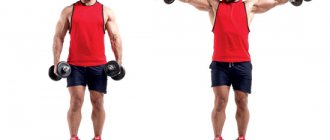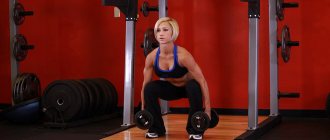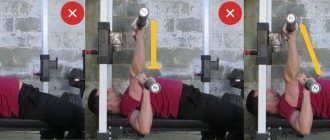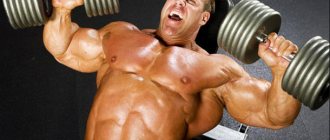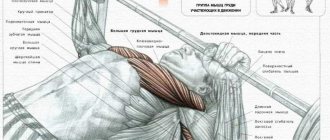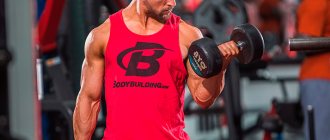Errors in dumbbell exercises
Dumbbells are an indispensable item when you need to perform any strength exercises. Many people think that there is nothing complicated about this. Yes, that’s right, they don’t require any special training, but even they have nuances that need to be taken into account in order to avoid injury.
- Consistently use dumbbells of the same weight category for all exercises. There is no need to do this, because not all muscles have the same strength and it is important to select dumbbells in order to specifically work the muscle. If you take dumbbells that are too light, you will not be able to give the desired load, and if, on the contrary, you take too heavy, you risk injury.
- While performing the exercise, you should try to relax your body in order to concentrate on the exercise itself, which will allow you to be in the correct position and reduce the risk of injury.
- Don't try to do everything quickly. Simply, you are not using all the capabilities of your muscles and there is no benefit from such exercises.
Seated dumbbell swings - diagram
1) Place dumbbells on each side of the bench, sit on the bench, lean forward and hold the dumbbells in your hands. 2) Dumbbells can be held in front of you, with your hands facing each other, or under your knees, resting the dumbbells against each other so that your palms face back. 3) If you hold dumbbells in front of you, then you should, spreading your arms to the sides, move the dumbbells apart from each other as if you were trying to pour water out of them. 4) If you hold dumbbells behind your legs, then you simply spread your arms to the sides, but to the sides, and do not pull the dumbbells behind your back. 5) After you have raised your arms as far as possible, which will happen approximately when your elbows are level with your shoulders, you should slowly and under control return the dumbbells to the starting position.
Seated dumbbell swings - notes
1) The elbows are always higher than the hands and further than the shoulders, that is, the elbows are closer to the legs than the shoulders. 2) No jerking is allowed, the movement should be smooth and controlled, if you have to jerk, it means you are using too much weight. 3) The arms should be spread out to the sides in a long amplitude, but the elbows should still be slightly bent so that the elbow joint does not experience excessive stress. 4) Learning to perform swings while sitting should be done using a simpler technique, when the athlete lifts the dumbbells by the legs and, accordingly, does not use supination. 5) It is advisable to lower your head down so that the trapezius muscle relaxes; this is necessary not so that it does not steal the load, but so as not to damage the cervical vertebrae.
Anatomy
The shoulders are represented by three deltoid muscles, which have different functions; they are separated from each other by fascia, so each bundle of deltoids can be considered a separate muscle. That is why each delta should be pumped separately, although in practice the middle delta cannot be worked in isolation; it can only be “hooked” during training of the front or rear deltas. Swinging dumbbells while sitting specifically loads the rear delta, but, of course, the middle bun also actively works on the side. However, despite the fact that several muscles are involved in the work, since the entire load falls on only one joint, and it is extremely fragile, the swing is an isolating exercise that should be performed carefully.
To sum it up, we can say that seated swings are one of the best exercises for training deltoids, but this exercise is not suitable for everyone. The point is not that not everyone will be able to perform it correctly, one cannot even say that it will be useless, but for beginners it is simply ineffective to use it. It’s best to save it for later, when you do a separate workout for delt training, or when you split the delt training into front and rear training. For example, the rear deltoid can be trained with the back, and the front deltoid with the chest, while the middle deltoid will receive an indirect load in both of these workouts.
Bodybuilding Exercises
Technique for proper dumbbell lifting
The most common exercise for working the front deltoid is swinging dumbbells in front of you. The correct technique for swinging dumbbells in front of you will be written below.
- Dumbbells should be held with an overhand grip, your back straight, your feet shoulder-width apart. Now they need to be taken in a different, closed way, and the palms turn out to be facing down.
- You need to inhale, and during this you need to raise one arm, making sure that the arm does not bend at the elbow.
- Raising your hand to shoulder level (higher is possible), lower it as you exhale. This algorithm of actions must be done with the left hand.
Iron Health
Dumbbell front raises are an isolated exercise aimed at working the anterior deltoid muscles. In addition, this exercise simultaneously loads the middle beam. This exercise can also be called - swinging dumbbells in front of you .
Like any exercise for the deltoids, lifting dumbbells in front of you requires proper execution technique.
Correct technique for lifting dumbbells in front of you
- Starting position: Take dumbbells in your hands and place your hands in front of your hips. Straighten your back, bend your arms slightly at the elbows and fix them in this position until the end of the approach.
- The dumbbells can be held in either of two positions - either an overhand grip (palms facing your hips) or a neutral grip (palms facing each other).
- Start raising your arms in front of you. Keep your elbows as still as possible - do not bend or straighten them. Perform the movement exclusively using the deltoid muscles.
- As you move, do not bring your arms together or spread them - the distance between the dumbbells should always be the same.
- The dumbbells should be raised to shoulder level or higher.
Practical tips and advice
When performing front dumbbell raises, use relatively heavy dumbbells for maximum training effect. You can increase the load on the deltoids by using a neutral grip and raising your arms 45 degrees above the horizontal (relative to the shoulder).
The front deltoids and partially the middle deltoids receive maximum load when they deviate from the vertical by 45 degrees at the lowest point and until they deviate by the same 45 degrees above shoulder level. When raising the arm above 45 degrees from the shoulder, the trapezius and serratus muscles are activated. In addition, lifting dumbbells in front of you slightly loads the upper area of the pectoral muscles.
To increase the load on the front deltoids, use a grip in which your hand holds the dumbbells from above. Do not engage your body and do not swing by tilting your shoulders back or pushing your pelvis forward. If you cannot perform the exercise “cleanly”, take lighter weight dumbbells. There are many options for performing front lifts. You can choose the most optimal one for yourself or alternate them periodically:
- Alternating dumbbell raises
- Front Raises
- Arm raises on the block (lower)
See also – “Training program for the anterior deltas.”
Video on the topic : “Correct execution of dumbbell lifts in front of you”
Tips for implementation
- During exercise, make sure that your body does not swing when lifting dumbbells.
- To work the deltoid muscles even better, you can add “palm inversion”: when lifting the dumbbells, the palms are facing up, and when lowering the dumbbells, turn them down.
- You need to lift the dumbbells to shoulder level or slightly higher.
- There is no need to use very heavy dumbbells, as there may be a chance that the torso will sway.
Useful tips
The deltoid muscles are responsible for gaining volume in the shoulder area, so they need to be worked as effectively as possible. In order for the deltoids to be better involved in the work, it is important to use not an empty bar, but a weighted barbell. It should rise to the level of the nose, since only at this moment the athlete will be able to feel maximum tension.
It is important to remember that the anterior and middle deltoid muscles begin to work only when the arm is 45 degrees below the vertical. Also, maximum tension occurs at the moment when the arm is raised above the shoulders by 45 degrees. If the barbell is raised even higher, the trapezius and serratus muscles will come into play.
Don't forget about proper breathing technique . By exhaling forcefully, weightlifters can help themselves lift heavier weights than they would without exhaling. In addition, proper breathing allows you to effectively saturate your muscles with oxygen, which leads to improved performance.
A good nutrition program for gaining muscle mass can be a great help in training!
After reading this article, you will be able to choose the right fitness dumbbells for women.
Types of exercises for swinging dumbbells in front of you
Lifting dumbbells can be done in two ways - standing or sitting. Swinging dumbbells in front of you while standing is aimed specifically at training the anterior deltoid muscle, so that it becomes larger and more prominent. For this variety, you should follow some recommendations:
- You need to take dumbbells with an overhand grip. When straightening, you should bend your lower back slightly, your chin is parallel to the floor, your arms are slightly bent - this is the starting position.
- After inhaling, you need to hold your breath a little and at this moment you need to slowly raise your arms to shoulder level. As you exhale, you need to lower the dumbbells.
- Do it the required number of times.
Swinging dumbbells in front of you while sitting is intended to train the middle and back of the deltoid muscle. The difficulty of these exercises lies in the fact that a person will no longer be able to help himself with his body, swinging when lifting dumbbells. Here are some recommendations for performing dumbbell lifts in this version:
- you need to sit on the edge of the bench, your back should be straight, the dumbbells should be taken with an overhand grip;
- the technique for lifting dumbbells is the same as in the techniques described above;
- It is important that the body does not swing, and you should not jerk the dumbbells; If this doesn’t work, it means the weight is chosen incorrectly.
Swinging dumbbells in front of you is an effective strength exercise, which is best combined with other exercises so that the deltoid muscle is specifically worked out. It is important not to forget about the weight of the dumbbells, because if the weight is selected incorrectly and the technique is not followed accurately enough, you can stretch the muscle. You don't have to be an athlete to do this type of physical activity. Dumbbell swings are not a mindless exercise in which the main thing is simply to raise and lower your arms, it is important to concentrate on it, only then can you perform it correctly and achieve the desired result.
cyWka.ru
Dumbbell swings in front of you are an isolating exercise aimed at developing the anterior deltoid muscles; it also involves the middle part of the deltoids, the upper trapezius and the upper part of the pectoral muscles (the so-called “collar”).
Swinging dumbbells in front of you is not something absolutely necessary, since the front deltoids are already well loaded during the bench press and any other types of work with the pectoral muscles. But nevertheless, this exercise allows you to draw a beautiful relief of the shoulders and upper chest. Performed as a “finisher” after basic exercises.
Execution technique
1) Stand up straight, arms down and slightly bent at the elbows (but not too much). Take the dumbbells with a straight (fingers pointing back) or parallel (palms facing the body) grip. In the first case they are in front of the hips, and in the second - on the sides.
2) Jump your arms forward to head level, and then slowly return to the starting position.
3) Inhale when you lower the dumbbells, and exhale when you lift them, after overcoming the heaviest part of the amplitude.
Execution options
There are many different variations of this exercise. Most often, athletes prefer to swing their arms alternately, since this option allows them to take on more weight. But some swing at the same time or in antiphase, that is, when one hand goes down, the other goes up.
You can do this exercise with dumbbells and while sitting. The advantage of this option is that it becomes almost impossible to help yourself with your body.
Some people swing dumbbells in front of them with a reverse grip, that is, with their palms facing up.
Almost exactly the same exercise is performed with a barbell or one dumbbell. At the same time, with a narrower grip, the load shifts to the inner part of the front deltas. The row in the block simulator is similar to that described.
Common mistakes and recommendations
1) Try not to sway from side to side or back and forth. The deltoid muscles should work, not the body and legs.
2) Do not bend or straighten your arms while performing the exercise. No need to connect biceps and triceps. The arm at the elbow joint remains bent at the same angle all the time.
3) The optimal height for lifting dumbbells is up to nose level. If you can’t lift the dumbbells at least up to your chin, take a lighter weight. On the other hand, there is no point in lifting them above your head either, since then the entire load is shifted to the upper part of the trapezius.


